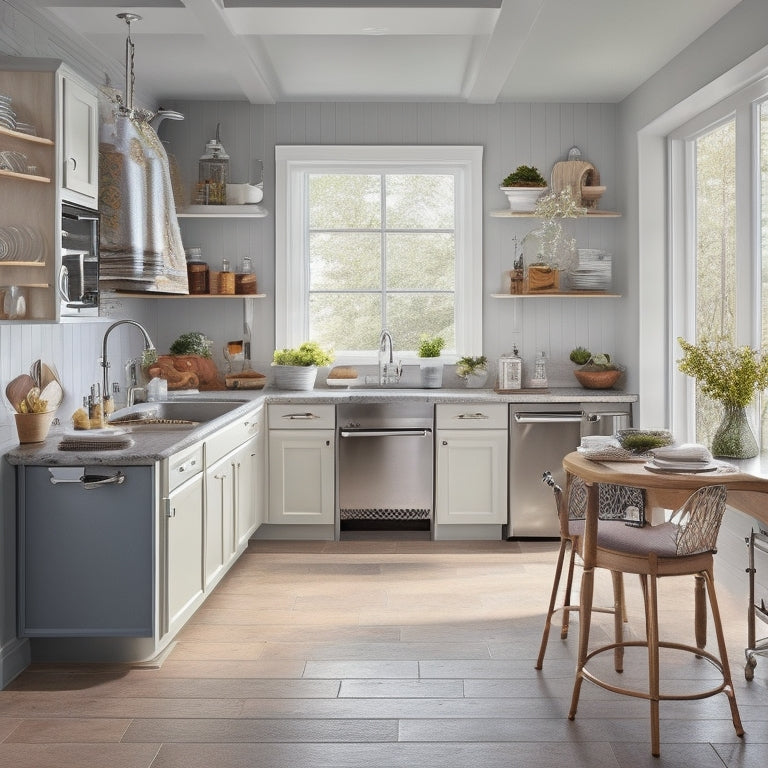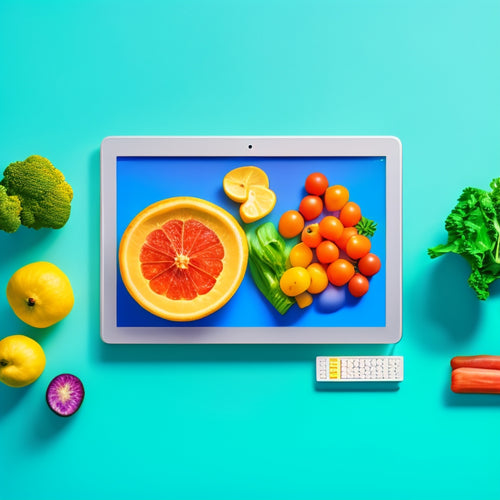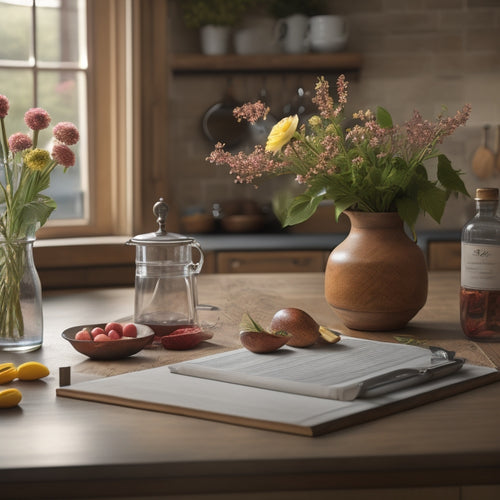
Accessible Kitchen Essentials for Independent Living
Share
You can achieve independence in the kitchen by incorporating accessible essentials that cater to your unique needs and abilities. Consider a kitchen layout that allows for easy navigation, with features like open shelving and pull-out cabinets. Adaptive utensils with larger grips or angled handles can make cooking easier, while smart storage solutions keep essentials within reach. Assistive technology, like voice-controlled devices, can simplify meal prep, and disability-friendly gadgets, such as automatic jar openers, can reduce strain. By incorporating these accessible essentials, you'll be cooking confidently and independently in no time – and there's even more to discover that can simplify your kitchen experience.
Key Takeaways
• Design a kitchen layout that prioritizes accessibility, with features like open shelving, pull-out cabinets, and comfortable counter heights.
• Utilize adaptive utensils with larger grips, angled handles, or adjustable lengths to facilitate independent cooking.
• Implement smart storage solutions, including organized drawers, functional pantries, and adjustable shelving, to keep essentials within reach.
• Leverage assistive technology, such as voice-controlled devices, smart scales, and digital meal planning tools, to simplify meal preparation and reduce physical strain.
• Incorporate disability-friendly gadgets, like automatic jar openers, easy-turn faucet handles, and non-slip mats, to enhance kitchen functionality and independence.
Kitchen Layout for Easy Navigation
You'll likely spend a significant amount of time in your kitchen, so it's essential to design a layout that allows you to navigate effortlessly. A well-planned kitchen can make a huge difference in your daily life, especially if you're living with mobility or dexterity limitations.
Start by considering counter height: make sure it's at a comfortable level that allows you to work without straining. This will also enable you to access cabinets easily, which is important for independent living. Look for cabinets with pull-out shelves or lazy susans to make it easier to access items at the back.
In addition, consider incorporating mobility-friendly features, such as open shelving. This won't only make it easier to access frequently used items but also reduce the need for bending or reaching. Open shelving can also help to create a sense of openness, making your kitchen feel more spacious.
Adaptive Utensils for Independent Cooking
With adaptive utensils, cooking becomes a more manageable and enjoyable experience, as they're designed to compensate for limited dexterity, strength, or mobility. You'll find that these utensils make a significant difference in your ability to prepare meals independently.
Look for adaptive utensils with features such as larger grips, angled handles, or adjustable lengths that fit comfortably in your hand. These modifications allow you to maintain control and precision while cooking, even with limited mobility.
In addition to adaptive utensils, consider incorporating cooking aids with inclusive design into your kitchen. These aids, such as one-handed jar openers or automatic can openers, simplify tasks that may be challenging with limited dexterity.
By combining adaptive utensils with user-friendly appliances, you'll create a kitchen that's tailored to your needs. This enables you to cook with confidence and independence, exploring new recipes and meal ideas without feeling limited.
With the right tools and modifications, you'll be empowered to take control of your cooking experience and enjoy the satisfaction of preparing meals on your own terms.
Smart Storage for Kitchen Essentials
Now that you've got the right tools for independent cooking, it's time to think about how to keep them organized and within reach, so you can focus on preparing meals efficiently. Smart storage solutions can make a huge difference in your kitchen, allowing you to access what you need quickly and easily.
| Storage Solution | Benefits |
|---|---|
| Organized Drawers | Space saving solutions, easy access to utensils and cookware |
| Functional Pantry | Accessible shelving, categorized storage for food and ingredients |
| Adjustable Shelving | Customizable storage for items of varying sizes |
| Pull-Out Cabinets | Easy access to heavy or hard-to-reach items |
Assistive Technology for Meal Prep
Assistive technology can greatly simplify meal prep by reducing physical strain and increasing independence in the kitchen. You can benefit from digital tools that help with meal planning, such as apps that suggest recipes based on your dietary needs and preferences. These apps can also generate shopping lists, making grocery shopping more efficient.
Assistive technology can also aid in cooking techniques. For instance, voice-controlled kitchen devices allow you to adjust cooking temperatures, timers, and other settings hands-free. This is especially helpful if you have limited dexterity or mobility. Additionally, smart kitchen scales can accurately measure ingredients, reducing the risk of errors. Some assistive technologies even provide step-by-step cooking instructions, making it easier to follow recipes.
Disability-Friendly Kitchen Gadgets
You can further enhance your kitchen setup with disability-friendly gadgets that cater to specific needs, such as adaptive utensils, easy-grip handles, and one-touch can openers. These innovative tools can greatly improve your independence and confidence in the kitchen.
Some must-have disability-friendly kitchen gadgets include:
-
Automatic jar openers that assist with mobility aids, making it easy to open jars with limited hand strength or dexterity.
-
Easy-turn faucet handles that simplify water control, reducing strain on your hands and wrists.
-
Non-slip mats and boards that provide a secure surface for food preparation, reducing the risk of accidents and injuries.
- One-handed kitchen shears that enable you to cut and prepare ingredients with ease, even with limited hand function.
Ergonomic Kitchen Tools for Comfort
Beyond adaptive gadgets, incorporating ergonomic kitchen tools into your setup can greatly reduce strain and discomfort, allowing you to cook with comfort and ease. You'll appreciate the benefits of ergonomic design in your kitchen, where repetitive tasks can take a toll on your body.
Look for utensils with comfortable grips, adjustable handles that fit your hand perfectly, and non-slip bases that provide stability. These features will help reduce fatigue and strain, making cooking a more enjoyable experience.
When choosing ergonomic kitchen tools, consider the knobs and handles. Opt for easy-to-use knobs that require minimal effort to turn, and handles that are designed for comfort and control. This is especially important for tasks that require precision, such as chopping or stirring.
With ergonomic kitchen tools, you'll be able to cook for longer periods without feeling exhausted. You'll have more energy to focus on the cooking process, and you'll enjoy the experience more. By incorporating these tools into your kitchen, you'll be able to cook with confidence and independence.
Personalized Kitchen Organization Systems
A well-designed kitchen organization system tailored to your specific needs can streamline meal prep, reduce clutter, and make cooking a more efficient and enjoyable experience. You'll be able to quickly find what you need, saving time and energy. By incorporating customized shelving and functional countertops, you can create a space that works for you, not against you.
Here are some ways to personalize your kitchen organization system:
-
Adjustable shelving: Install shelves that can be adjusted to accommodate items of different sizes, ensuring everything has a designated spot.
-
Pegboard storage: Utilize a pegboard to hang frequently used items, such as utensils, pots, and pans, keeping them within easy reach.
-
Drawer dividers: Organize your drawers with dividers to separate items, preventing clutter and making it easier to find what you need.
- Countertop zones: Designate specific areas on your functional countertop for food preparation, cooking, and storage, creating a smooth workflow.
Frequently Asked Questions
Can I Install Accessible Kitchen Features on a Limited Budget?
You can install accessible kitchen features on a limited budget by exploring DIY modifications, cost-effective solutions, and affordable kitchen gadgets that offer creative options, allowing you to achieve independence without breaking the bank.
How Do I Choose the Right Kitchen Accessories for My Specific Needs?
You'll want to identify your specific needs and preferences to select the perfect kitchen accessories. Look for customized solutions offering versatile options that blend functional design with stylish choices, ensuring your kitchen is both accessible and beautiful.
Are There Any Kitchen Modifications That Can Be Rented, Not Bought?
You might think renting kitchen mods is a hassle, but surprisingly, it's a cost-effective solution for short-term accessibility needs. Look for companies offering rental options for temporary modifications, perfect for recovering from an injury or testing out a new setup.
Can I Hire a Professional to Design an Accessible Kitchen for Me?
You can hire a pro to design a kitchen tailored to your needs, but consider your DIY skills and budget first; custom designs offer more flexibility, while pre-made solutions might be more affordable.
Are Accessible Kitchen Features Only for People With Permanent Disabilities?
You might think accessible kitchen features are only for those with permanent disabilities, but they're also beneficial for you if you're recovering from temporary injuries or planning to age in place, ensuring your kitchen remains functional and safe.
Related Posts
-

10 Best Online Low-Carb Meal Planning Courses
You're looking for a structured approach to low-carb meal planning, and online courses can provide the guidance and s...
-

10 Best Free Printable Kitchen Planner Templates
You're looking to whip your kitchen into shape with some free printable kitchen planner templates! You've come to the...

